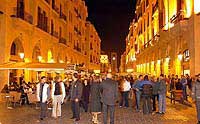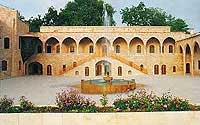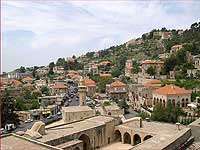|
NKT - 02 - Beirut,
Beiteddin & Deir el Kamar
(full day with lunch) |
Capital of Lebanon and Heart of the Middle East, Beirut rises again from
the aches. We visit the National Museum, the city center with its huge
construction sites, renovation works in addition to newest archeological finds.
A visit that will confirm the Lebanese will of making their capital again the
economic, touristic, cultural & commercial center of the Middle East.Deir El-Kamar,
typical Lebanese village where we visit the Kayssarieh, Notre Dame Churh,
Fakhreddine Mosque and Marie Baz museum.
At a small distance, we visit Beiteddin, Palace of Emir Bechir (1788 - 1840) and
summer palace of the Lebanese Presidents from 1943 till 1983. Lunch is served in
a very good Lebanese restaurant.
|
|
Beirut
Beirut was built on a rocky promontory, a site also occupied by
prehistoric man. In ancient times it was overshadowed by
powerful neighbors, but when the city- states of Sidon began to
decline in the first millennium B.C, Beirut acquired more
influence. During Romans times, Beirut became a roman colony (15
B.C), and an important port and cultural centre. During the
roman and Byzantine eras it was distinguished for its law
school, whom professors helped draft the famous Justinian code.
Beirut was destroyed by a devastating earthquake in 551 A.D. A
century later, it was conquered by the Muslim Arabs and in 1109
it fell to the crusaders. The city remained in crusader hands
until 1291, when it was taken by the Mamluks. |
 |
In 1516 the 400- year ottoman rule began. Later, in the 17th
century, Beirut knew a period of great prosperity under the
government of
emir Fakhreddine II. Then with the break –up of the Ottoman
Empire at the end of the World War I, the city became the
capital of modern Lebanon.
Beirut, with nearly a million inhabitants, remains the cultural
and commercial centre of the country. Some of its main landmarks
are:
the martyrs’ statue, the Souks (markets) and the parliament
building, which are part of the design covering 1.8 million
square meters. In extensive archeological investigations,
historical periods ranging
from Canaanite (3,000- 1200 B.C) to ottoman (1516-1918 A.D),
have been revealed. |

 |
|
|
|
Beiteddin
Forty -three kilometer from Beirut stands this magnificent palace
built at the beginning of the 19th century by Emir Bechir II, who
reigned over Lebanon for more than 50 years. With its arcades, galleries
and rooms decorated by artists from Lebanon, Damascus and Italy, this
building is a model of eastern architecture.
Today the palace houses a museum of feudal weapons, costumes and jewelry
as well as an archeological museum and a museum of Byzantine mosaics
|

|
|
|
|
Deir el kamar
Deir el Kamar was the capital of Mount Lebanon, located
35 km away from Beirut, now it is a typical Lebanese village
with its historical center, souk(market), museum, mosque
& churches.
|
 |
To order any of these tours email us
Tours@Lebanon.com. Please
specify which tour you are interested in and when you plan on arriving
and departing Lebanon.
|
|
|